International Yoga Day- Common Yoga Protocol
Disclaimer- This document about the International Yoga Day has been created by Team Bharatha Yoga to create more awareness to the general public about yoga, its benefits, do’s and dont’s. This is not a substitute to any medical advice of your physician for any ailments. Bharatha Yoga does not assume any responsibility or liability for any injury caused as a result of the practice mentioned in the document.
Message from Prime Minister – International Yoga Day
“Yoga is an invaluable gift of ancient Indian tradition. It embodies unity of mind and body; thought and action; restraint and fulfillment; harmony between man and nature and a holistic approach to health and well-being. Yoga is not about exercise but to discover the sense of oneness with ourselves, the world and Nature. By changing our lifestyle and creating consciousness, it can help us to deal with climate change. Let us work towards adopting an International Yoga Day.”

Opening Prayer
Prayer
ॐ Samgacchadhvam samvadadhvam
sam vo manāmsi jānatām
devā bhāgam yathā pūrve
sanjānānā upāsate
Meaning
May you move in harmony
May you speak in unison
Let our mind be equanimous like in the beginning
Let the divinity manifest in your sacred endeavors.
ASANA PRACTICE
Chalana Kriya
Neck Bending (Neck Movement)
Place your feet hip-width apart. Place your hands on the hips. Do the following neck movements:
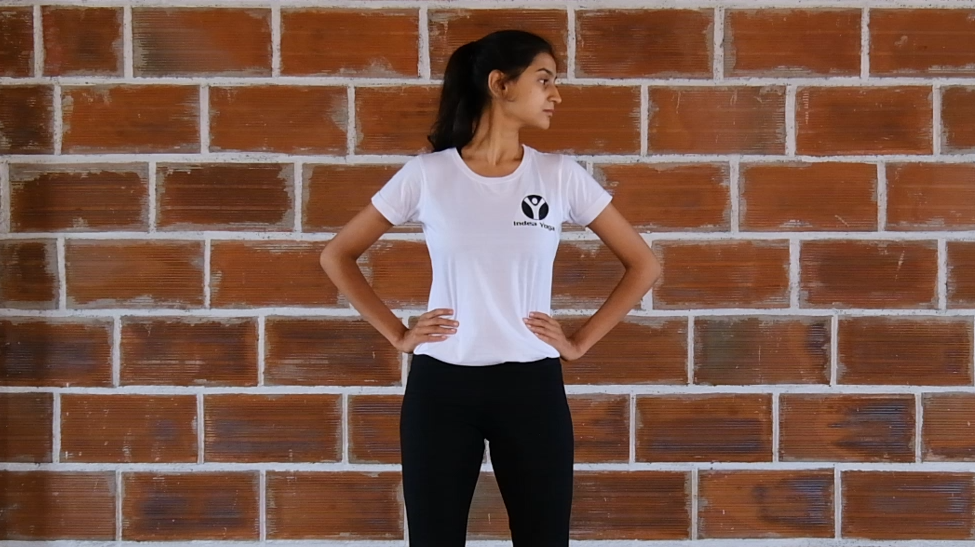
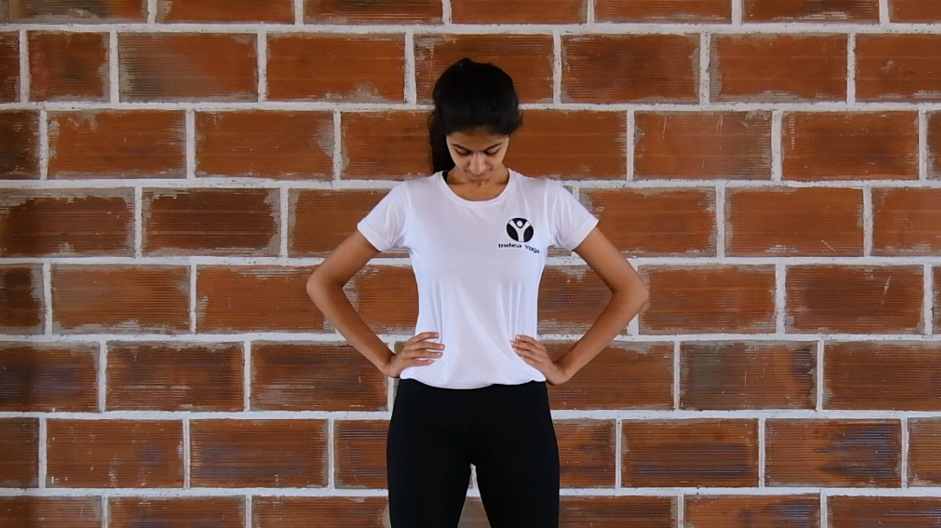
Front to back – Slowly bring the chin down to chest, then backwards to look up (Repeat 5 times each side).
Shoulder Movement
Start in samastithi, palms by the side of the body. Inhale and raise your arms up, exhale and release. Repeat 5 times.
Rotation– From samastithi, touch your shoulders with the finger tips. Rotate fully, bringing the elbows together, out to the back, up and to the front. Repeat 5 times clockwise, 5 times anticlockwise.
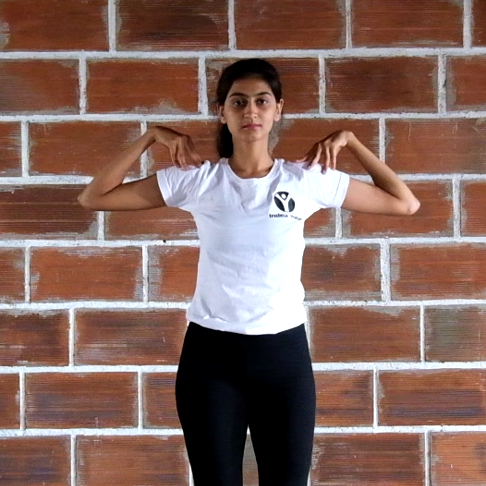
Trunk Movement (Spinal Twist)
Spread feet 1-1.5 meters apart. Keep the spine and feet straight and the eyes open. Bring the together, palms facing downwards on the chest at shoulder level. Move from the waist, exhaling to the right, inhaling center, exhaling to the left. The eyes follow the elbows. (Repeat 15 times).
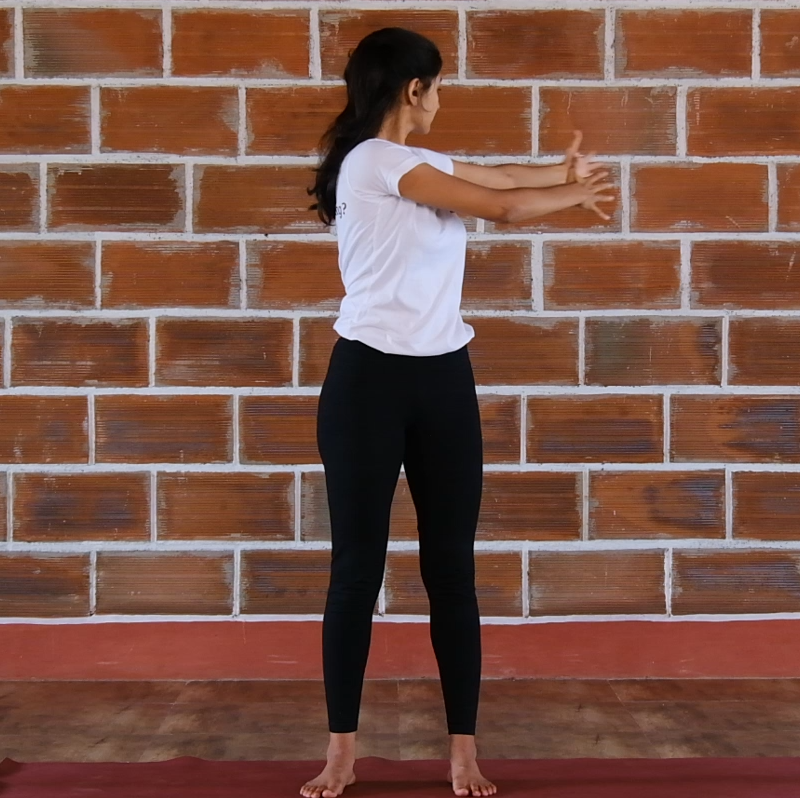
Knee Movement
Inhale, lift the arms to shoulder level palms facing down. With an exhalation, bend the knees to squatting position. While inhaling, straighten the knees. Repeat 3 times.
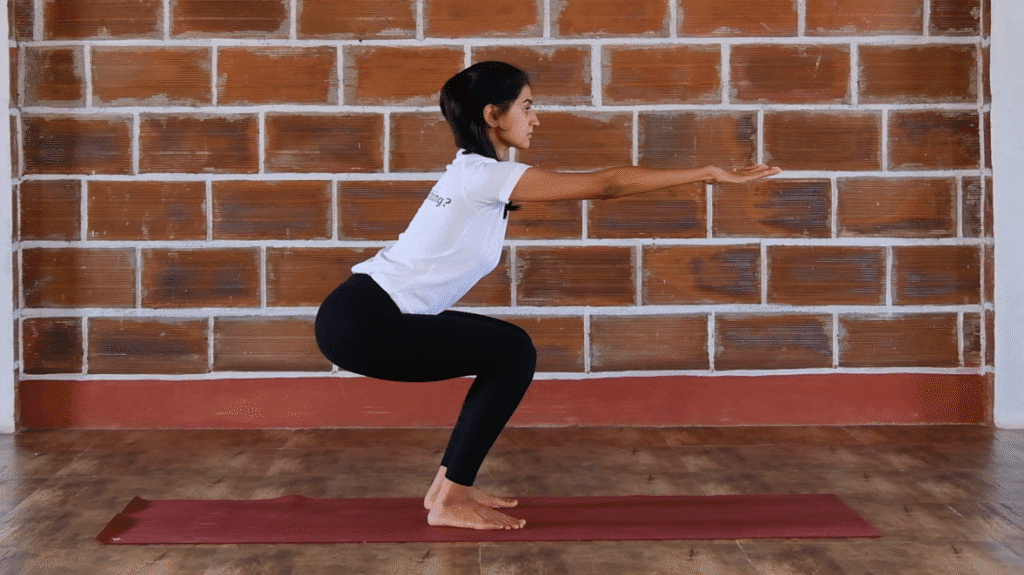
Standing Postures
Tadasana (Palm Tree Posture)
Stand straight and lift the spine up. Place your feet together. Keep your eyes open and focus on an unmoving point. Place your palms on your thighs and as you inhale raise the heels up and raise the hands out in front and straight up above the head. Keep the fingers open. Exhale, release hands back down and release your heels back to starting position. Coordinate your body movements with your breath.
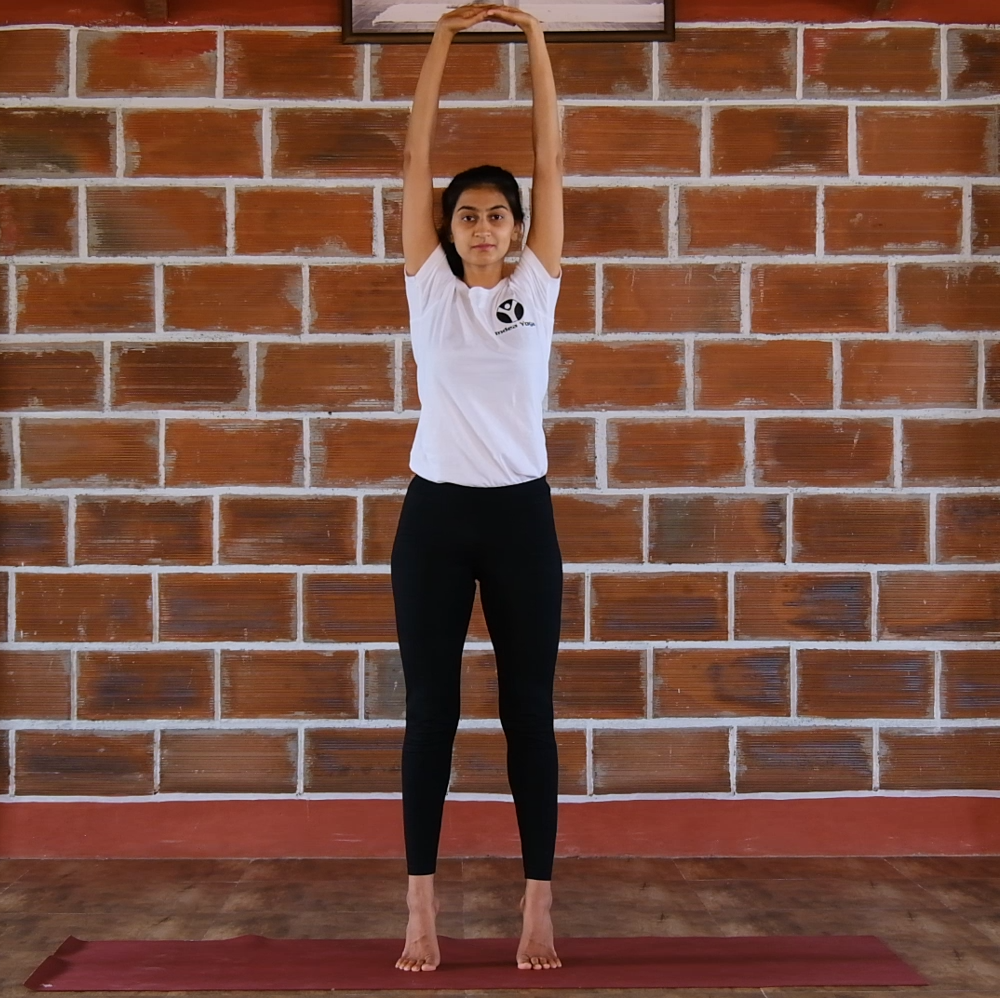
Vrkshasana (Tree Posture)
Begin in Tāḍāsana. Look straight ahead focusing on an unmoving point. Shift the entire body weight onto the left foot. Get well grounded. Bend at right knee. Then, bring the right foot up onto the left thigh placing the right heel against the left groin and square the hips. Knee should be stretched out to the side and toes pointed downwards. Lift the spine well. Bring hands into Namaskāra mudrā. Once stable, inhale and stretch the arms up. Open the sides well, pull the abdomen in and tighten the buttocks. Stay in position for 30 to 60 seconds. Release hands down. With hand support, release the right leg. Repeat on the other side.
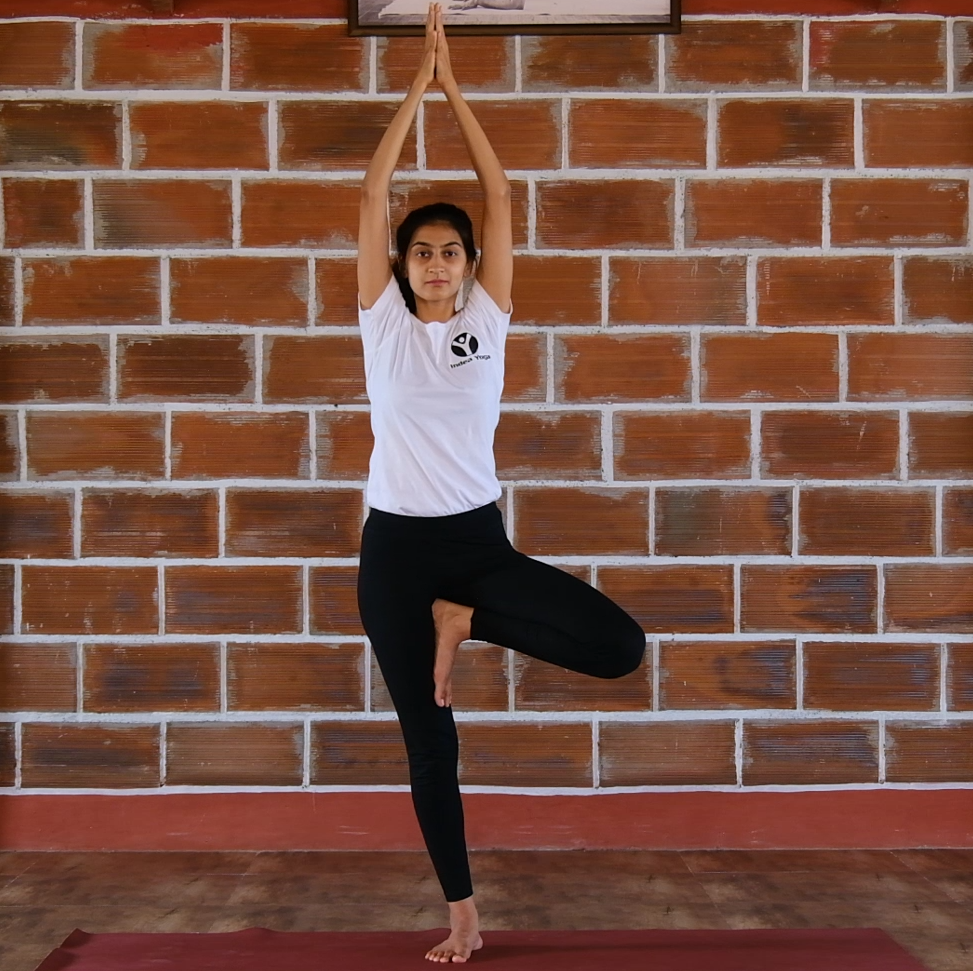
Padahastāsana (The Hands to Feet Posture)
Inhale and place the palms under the feet, concave the back, lift the head without bending the knees. Then, exhale, tuck in the lower abdomen and place your head in the region between two knees. Keep the elbows slightly bent. Extend down with each exhalation. Hold the pose 30-60 seconds. Release the hands and place the palms on the waist, Inhale slowly, come up half way (table top) and take a breath here, roll the shoulders than inhale again come back up to standing and Tāḍāsana.
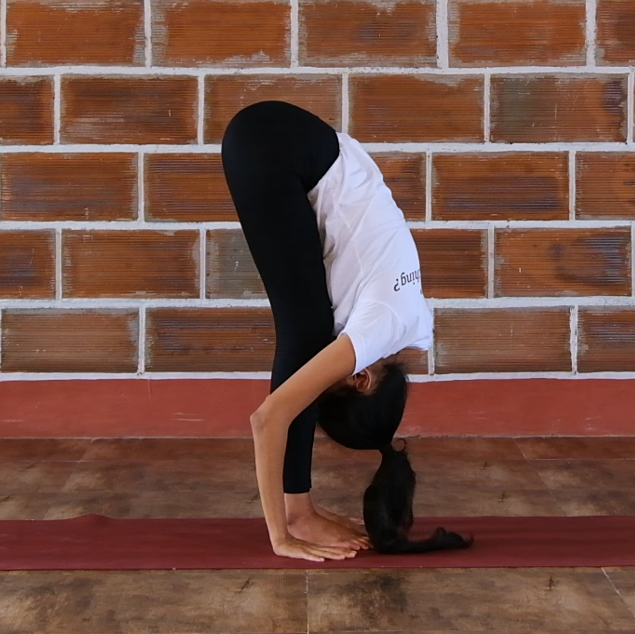
Ardha Chakrasana (The Half Wheel Posture)
Begin in Tadasana, then take feet shoulder width apart, hands in namaskar mudra in-front of the chest, bend the knees to the maximum, tilt the pelvic, inhale and slowly start to drop back, after each inhale pause then exhale and then go further back, continue to drop upto your comfortable limit. Slowly come back up back to tadasana.
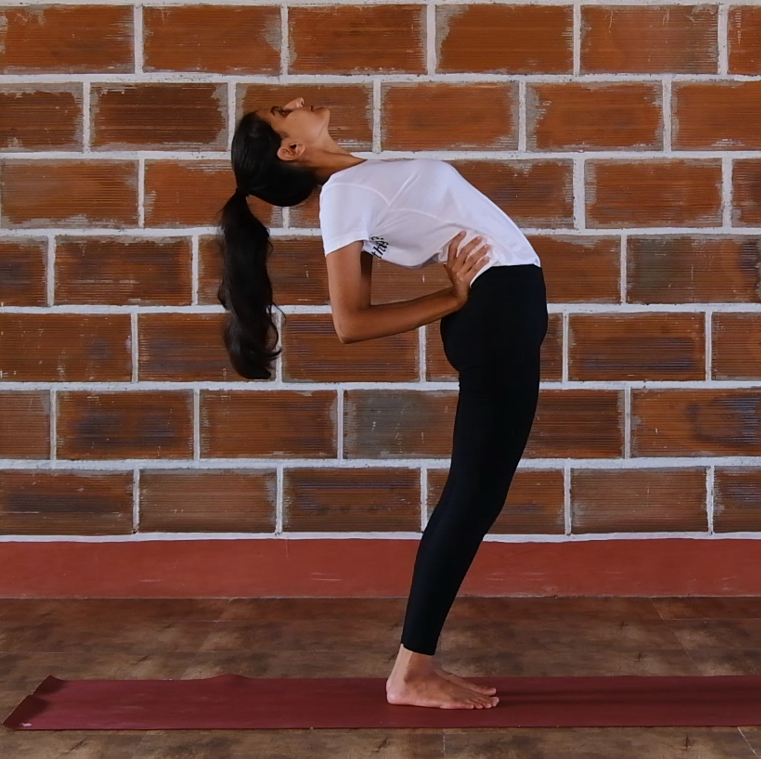
Trikonasana (The Triangle Posture)
Begin with Tāḍāsana. Move to Uttitha Hastapadāsana and then Pārśva Hasta Padāsana. Turn the palms to face the front with fingers active and well spread. While exhaling, bend to the right from the waist and turn the neck up in the direction of the left thumb. Left arm should be straight up. Keep equal weight on both feet. Hold for 30 – 60 seconds. Inhale up to Pārśva Hasta Padāsana, then Uttitha Hastapadāsana. Repeat on the left side and then step by step go back to Tāḍāsana.
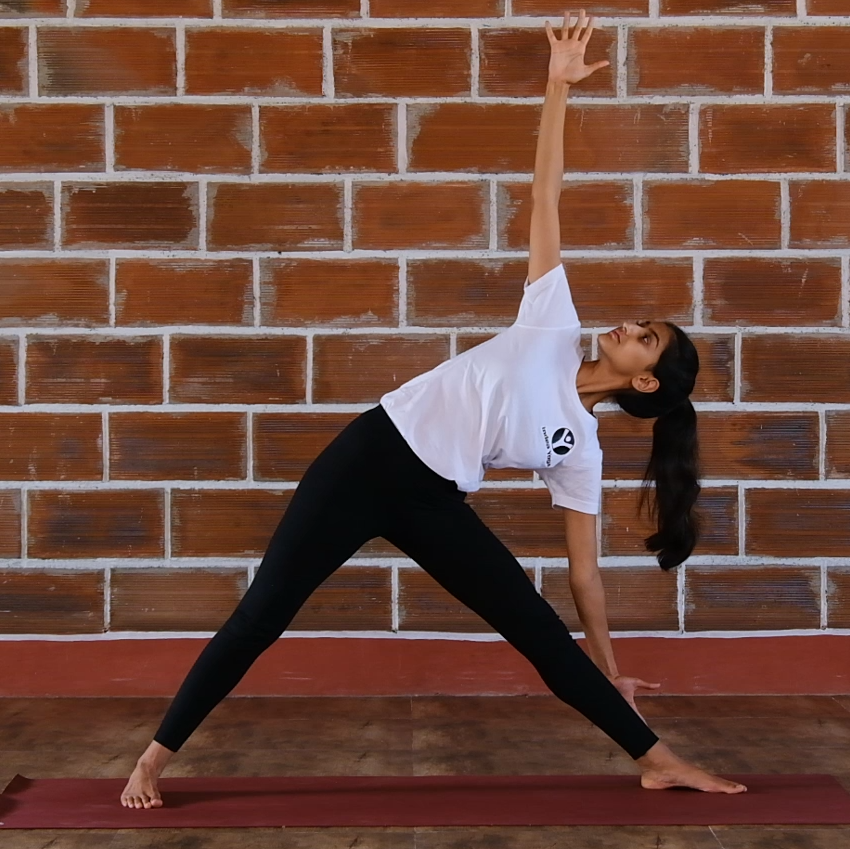
Sitting Postures
Bhadrasana (The Firm/ Auspicious Posture)
Begin with Daṇḍāsana. Gradually, bend both knees out to the side, bringing the soles of your feet together. Place the heels in front of the pelvis, about a fist distance from the groin. To gain lift & length in the back you can bring the hands behind you. Then take hold of your feet with your hands, opening your feet “like a book”. Exhaling, bend forward and bring the face or forehead to the mat. Hold for 30 to 60 seconds. Inhaling, come up. Release the legs back to Daṇḍāsana.
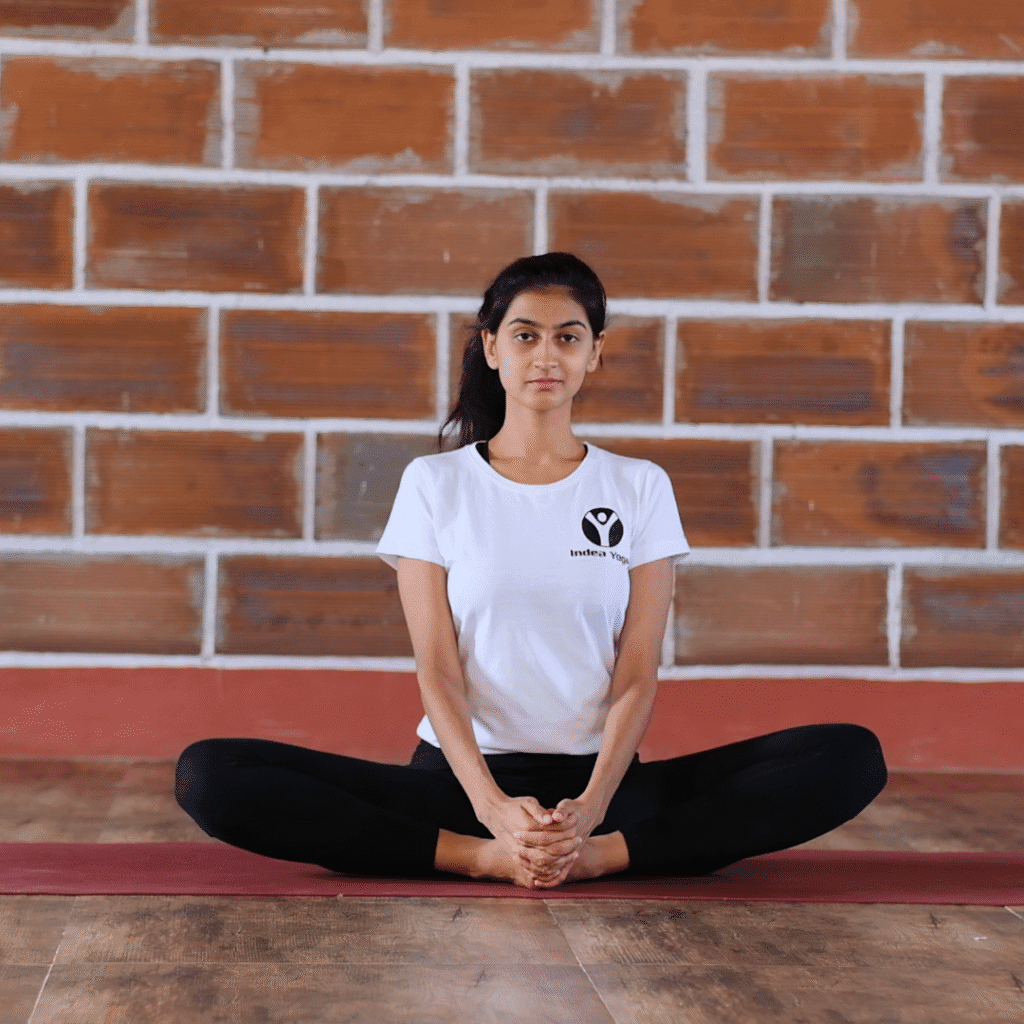
Ardha Ushtrasana (The Half Camel Posture)
Begin from sitting on your knees, in Vajrasana. The distance between your knees will be shoulder width apart. Take your hands on your lower back fingers facing downwards. Push your hips forward, roll your shoulders, inhale and slowly drop the upper body backwards, while simultaneously pushing the hips forward. Inhale and slowly come back up.
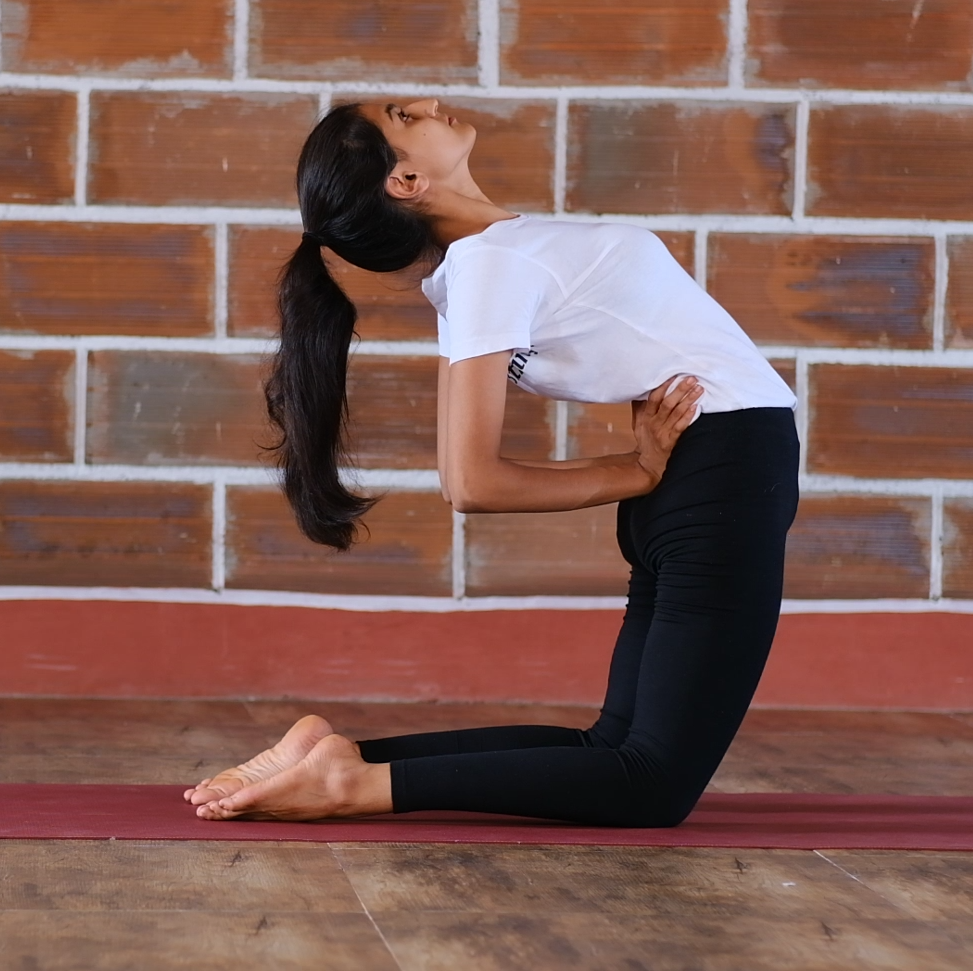
Ushtrasana (The Camel Posture)
Begin from sitting on your knees, in Vajrasana. The distance between your knees will be shoulder width apart. Take your hands on your lower back fingers facing downwards. Push your hips forward, roll your shoulders, inhale and slowly drop the upper body backwards, while simultaneously pushing the hips forward. If you’re still comfortable, take your palms on the heels. Inhale and slowly come back up.
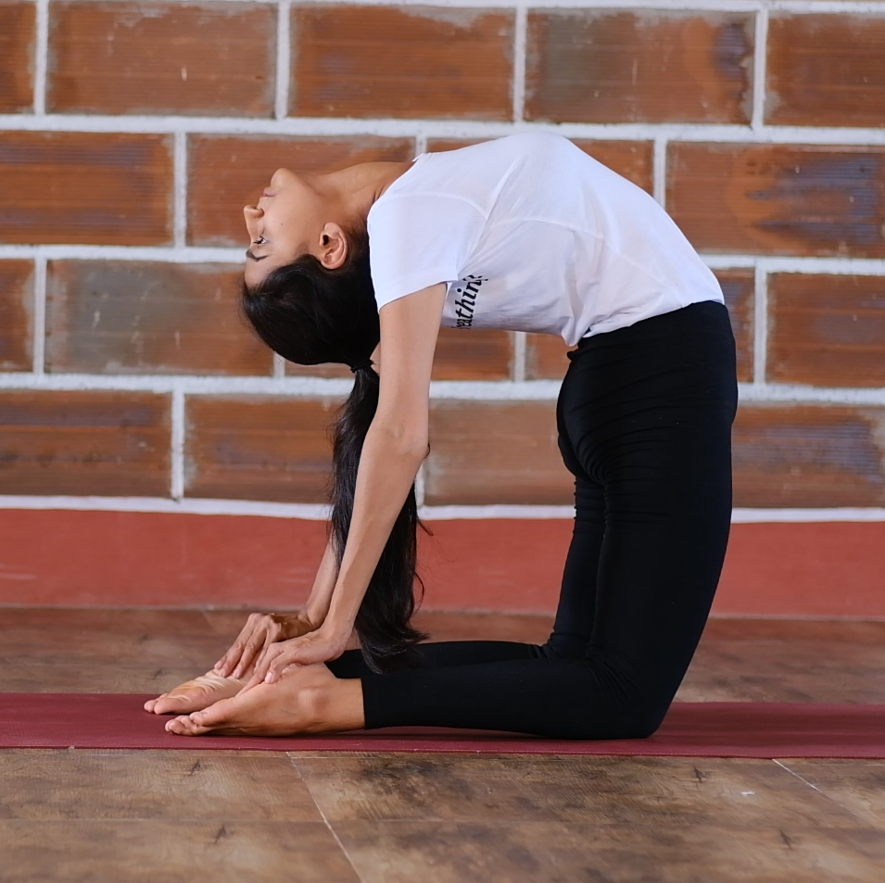
Sasankasana (The Hare Posture)
Keeping the feet and knees shoulder width apart or wider, push back and rest the buttocks on the heels. Place the forehead on the mat and stretch the arms out in front.
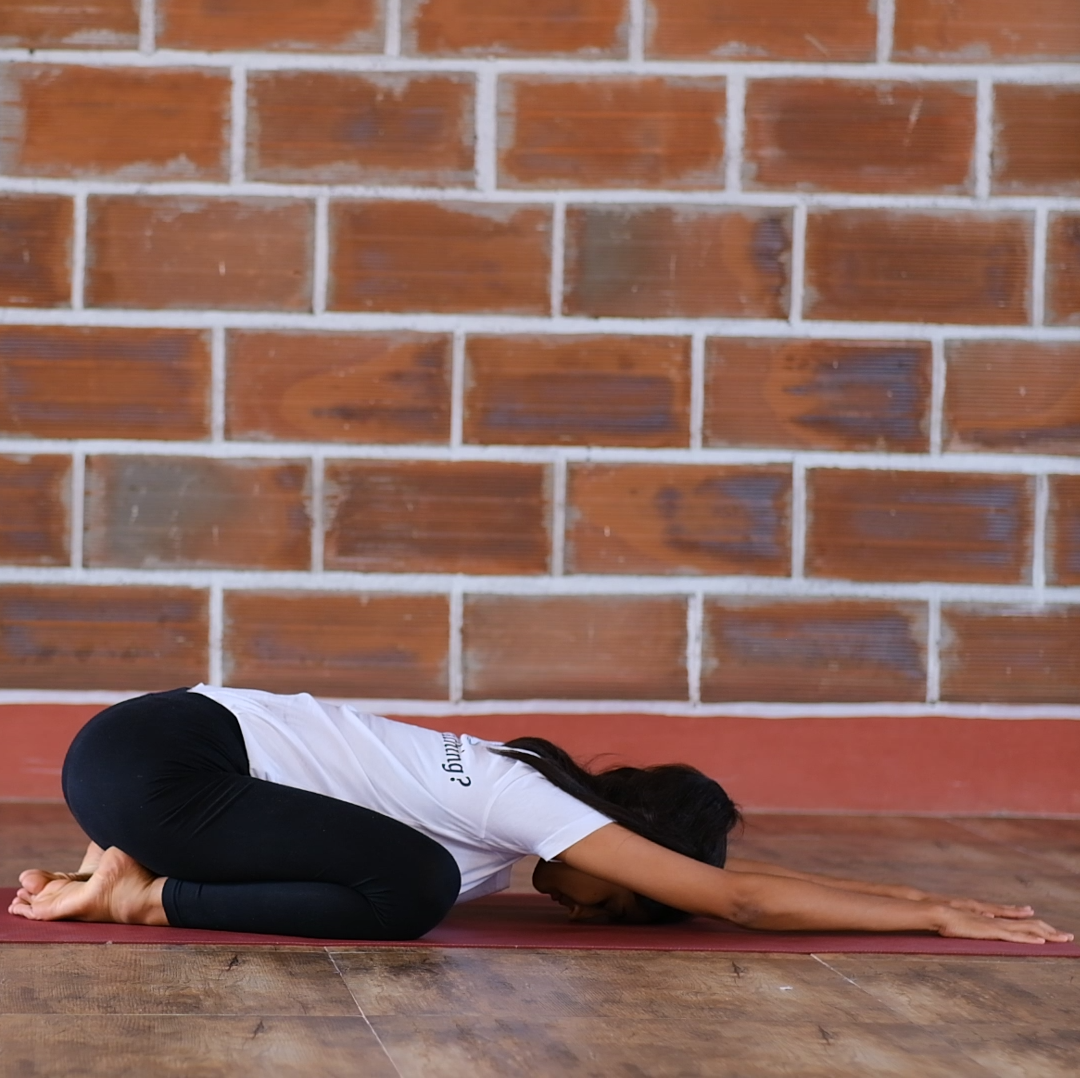
Uttana Mandukasana(Stretched up frog posture)
Sit comfortably in Vajrasana, take the knees wider, bringing the big toes together at the back. Take your right hand, bend it at the elbow, and place the right palm on the left shoulder blade. Similarly repeat the technique for the left palm. Stay in the posture for a few breathes, and gently release from the asana.
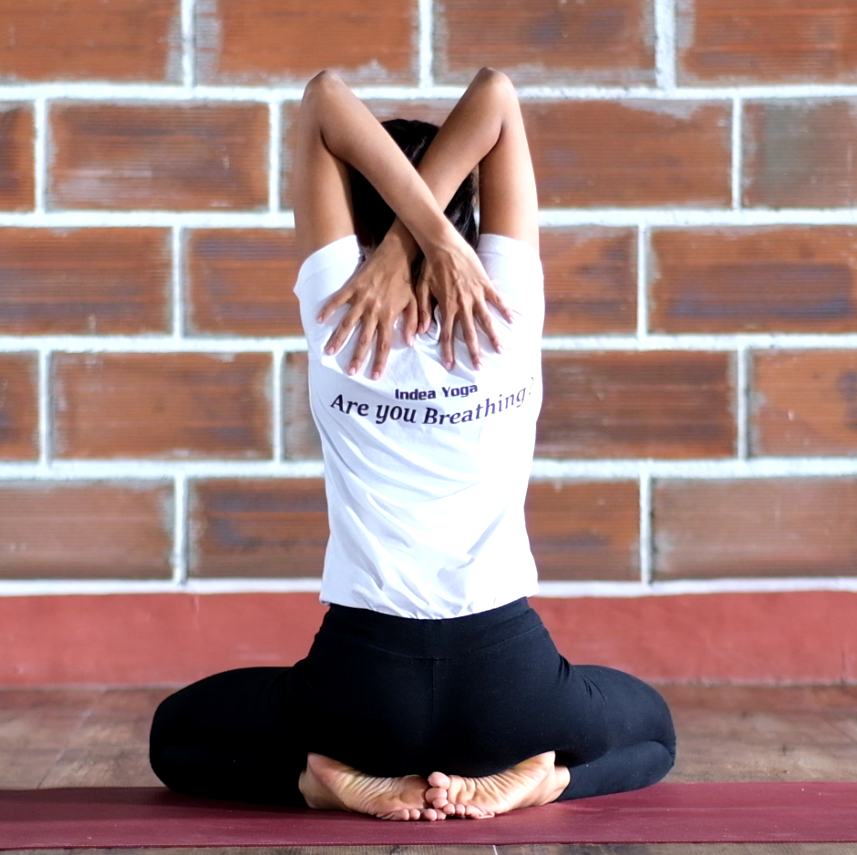
Vakrasana (The Spinal Twist Posture)
Begin with Daṇḍāsana. Bend at the right knee and place the right heel next to the left knee. The knee should be pointing upwards towards the ceiling. Make sure that the right foot is about a fist distance from the left leg. Lift and lengthen the spine. Then, twist to the right. Place the left armpit over the right leg. Lift and lengthen the trunk. Gradually grab the left foot. Take the right arm behind the back and place it on the mat. Hold for 30 to 60 seconds. Slowly release the hands. With hand support, release the right leg. Step by step get back to Daṇḍāsana. Repeat on the other side.
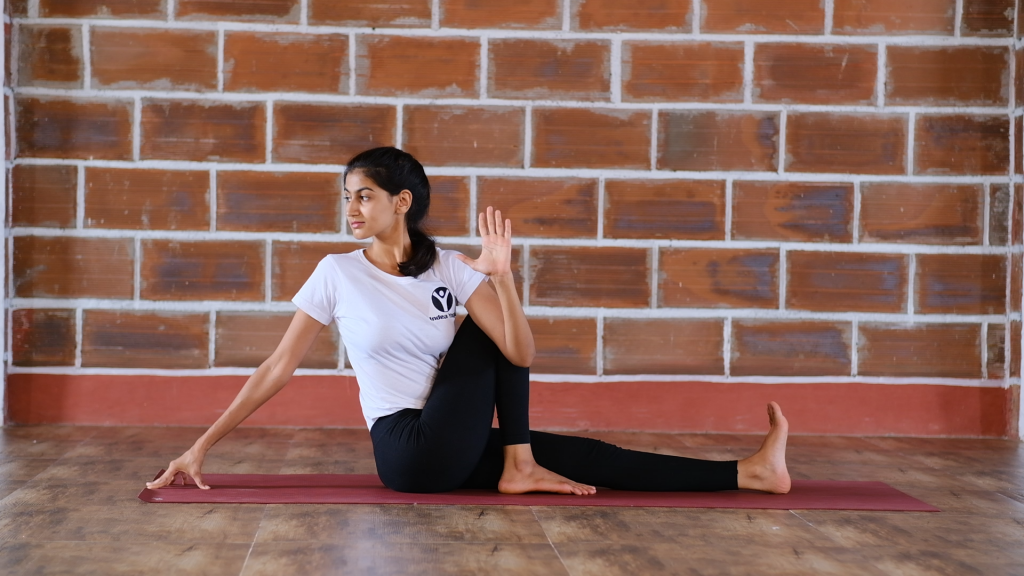
Prone Postures
Makarasana (The Crocodile Posture)
Lie on the stomach. Keep the legs well apart with the heels facing each other and the toes pointing out. Fold the right arm and place the palm on the left shoulder, then left palm on right shoulder. Rest the chin on the point where the arms cross.
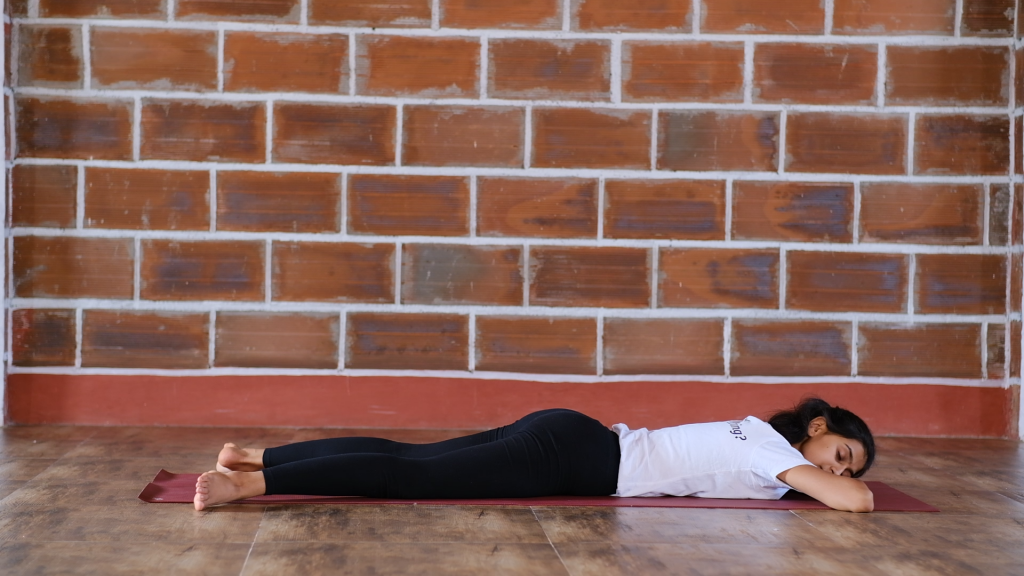
Bhujangasana (The Cobra Posture)
Lie on the stomach with your chin down on the mat. Place the hands on either side of the chest in line with the nipples. Fingers should be well spread. While inhaling, slightly tighten the buttocks and the knees and lift the upper body. Look forward. Take no weight on the hands; they are only there for support. Elbows need to stay close to the body, chest open. Waist below the navel remains on the floor. Legs should be together and active with the toes touching. While exhaling gently come down.
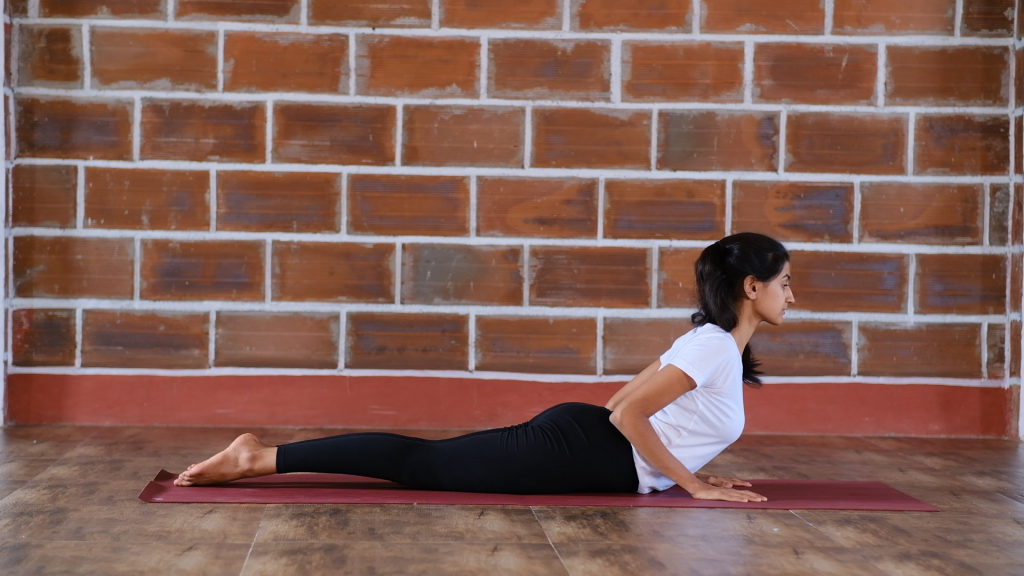
Salabhasana (The Locust Posture)
Lie on the stomach. Place the palms underneath the pelvic region on either side of the body with the palms facing up. Chin down on the mat, shoulders relaxed. Mild contraction of the buttocks makes lifting easier. Then inhale and lift both the legs of the mat. Take 5 deep and long breathes. While exhaling release the legs.
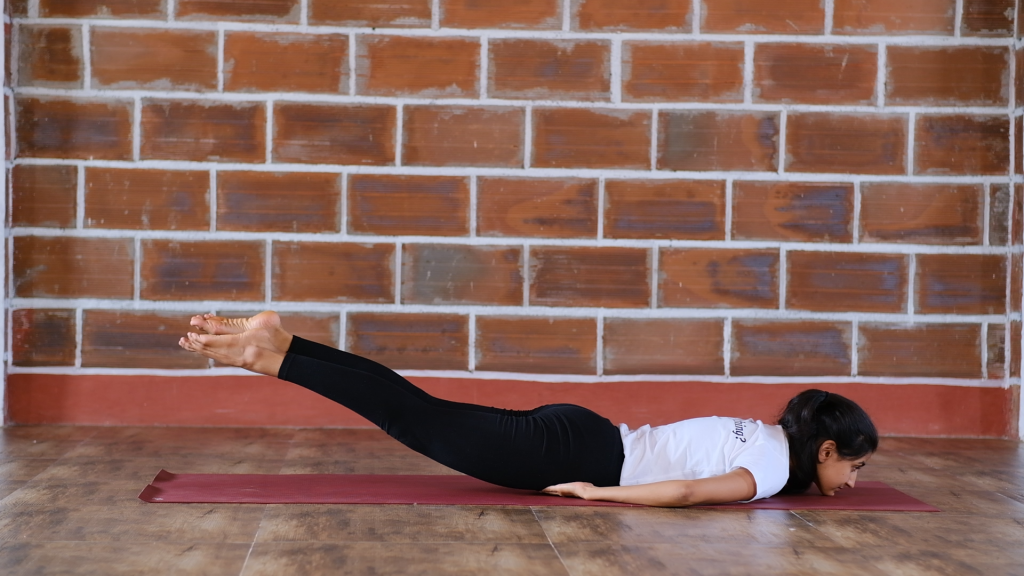
Supine Postures
Setubandhasana (The Bridge Posture)
Lie on the back, bend the knees and bring the feet near the hips. A foot’s distance should be taken between the heels and hips. Legs should be shoulder distance apart with the feet and knees in line. Hands hold the ankles or by the sides. Neck should be free. Without disturbing the feet or knees, inhale and contract the perineum (this releases back tension). Lift the waist up arching the spine and expanding the chest. Shins should be at 90 degrees to the floor. Weight should be on the shoulders and the feet. While exhaling continuously, release back down vertebrae by vertebrae.
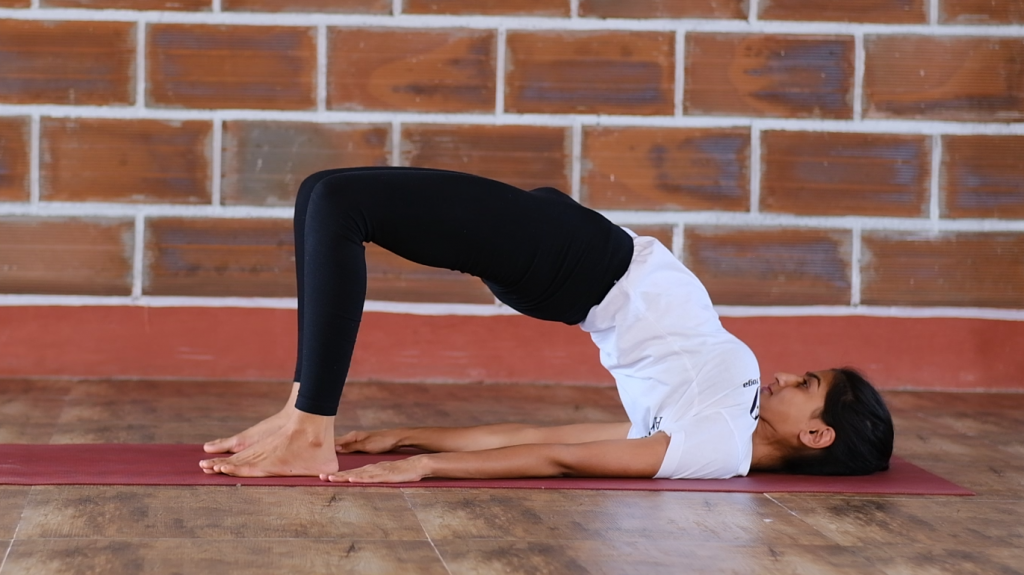
Uttana Padasana (Raised feet Posture)
Lie on the back with the legs active and the feet together. Spread the toes and stretch the outer edge of the foot out. Keep the by arms the sides of hips. Keep the legs and knees straight. Inhale and lift both legs up to 30 degrees. Stay in the position for around 30 to 60 Secs and breathe deeply. While exhaling release the leg.
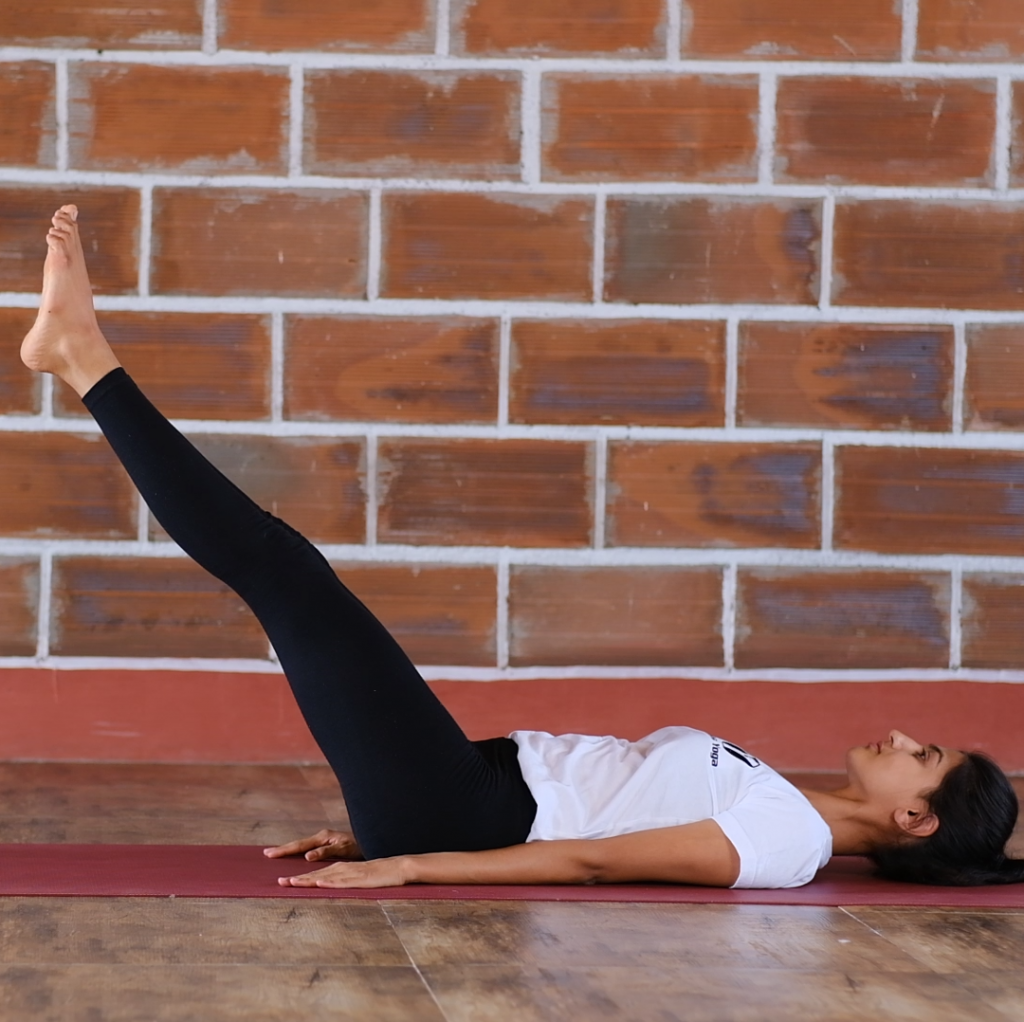
Ardha Halasana (Half plough posture)
Lie on the back with the legs active and the feet together. Spread the toes and stretch the outer edge of the foot out. Keep the by arms the sides of hips. Keep the legs and knees straight. While inhaling, lift both legs up to 90 degrees. Stay in the position for around 30 to 60 Secs and breathe deeply. While exhaling release the leg.
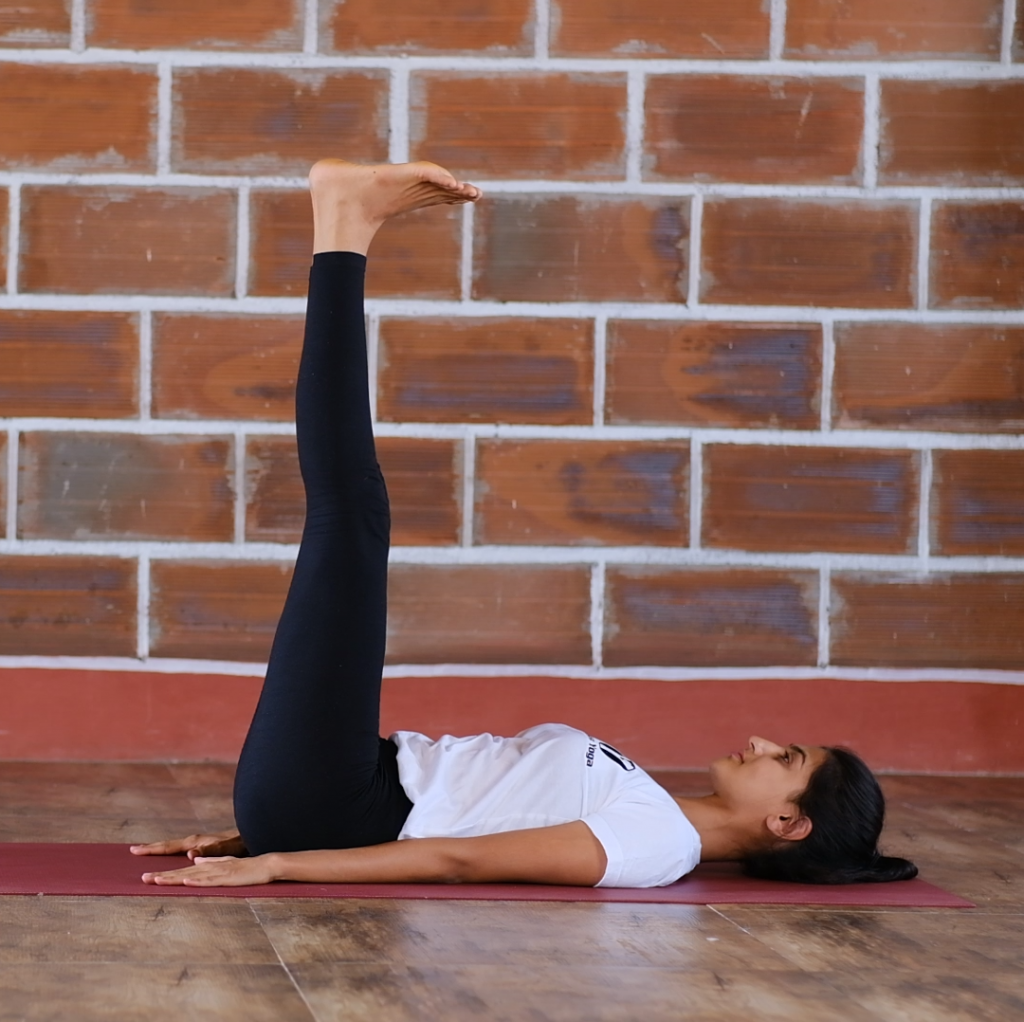
Pavanamuktasana (The Wind Releasing Posture)
Lie on the back. On exhalation bring both legs up. Hug the knees around the outside or inside of the knees. Hips come up and the chin lifts between the knees. Inhale and release.
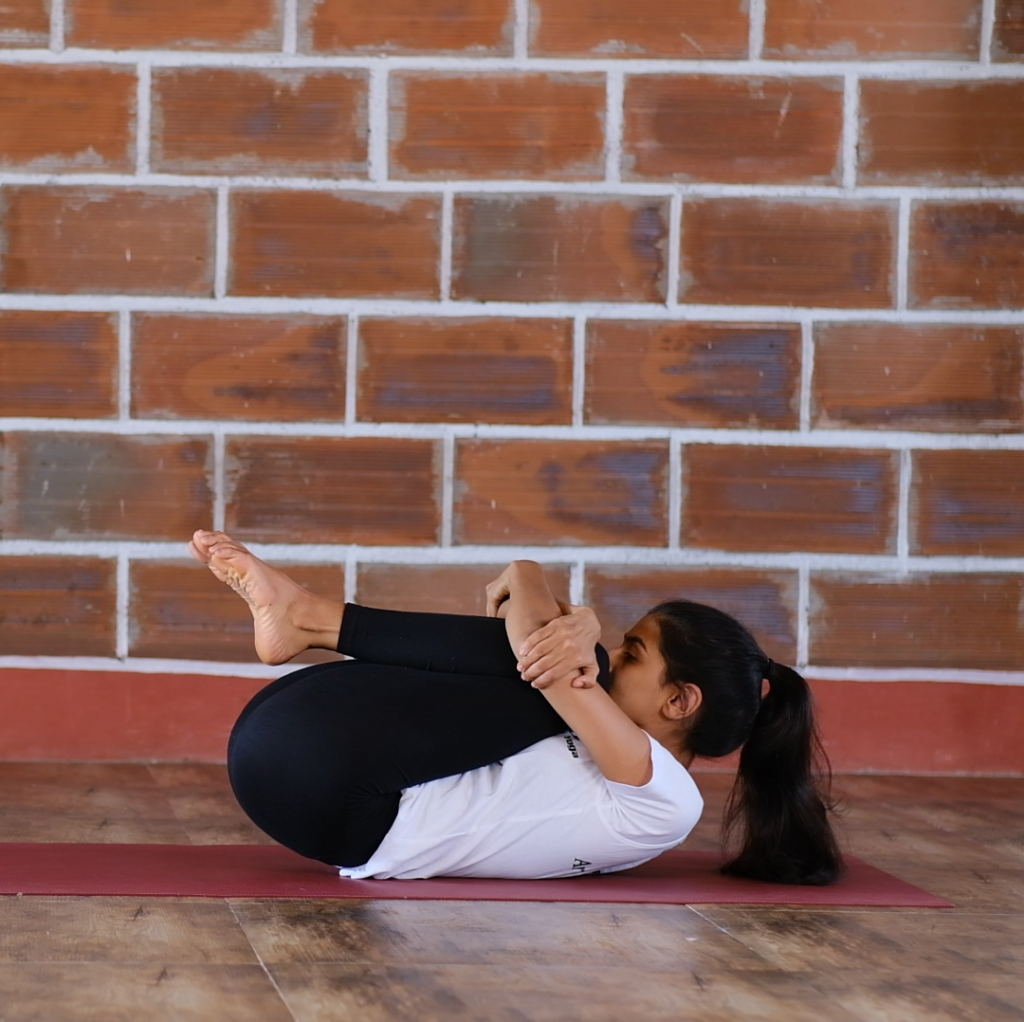
Savasana (The Dead Body Posture)
Lie down on the back, stretching the legs out. Make sure the body is in a straight line. Palms should be facing up, fingers relaxed. The first finger should be touching the floor; this ensures that the shoulders roll outwards. Chest should not collapse, but should be relaxed. The toes and feet should be rolled out. The legs should be slightly apart and the arms should be away from the sides of the body. Release the joints and muscles. Close the eyes. Observe the changes in the body, mind and breathe.
To get up, bring the legs together, stretch the right arm up over the head, place the left palm on the abdomen, bend the left leg at the knee. Roll onto the right side, place the left hand down on the ground- in front of the chest- and wait for a few moments. Use both hands to support the body and get into a comfortable sitting position.
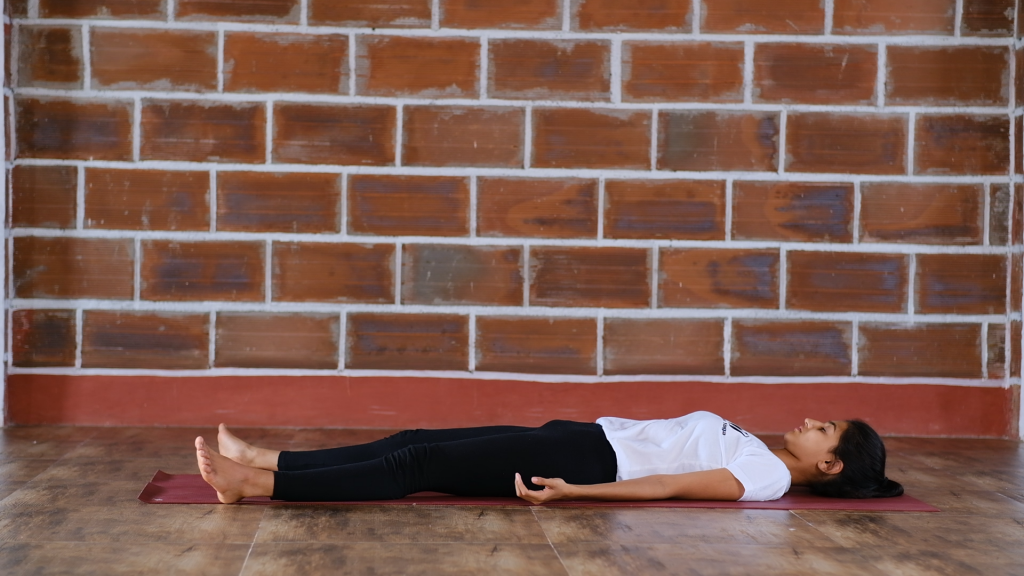
Kapalabhati
Sit in any comfortable and steady meditative position, with the head and spine straight and the hands rested on the knees in Chin or Jnana mudrā. Close the eyes, relax the face, body and mind. Do a few rounds of natural breathing. Exhale forcefully, feel the abdomen contract. Inhalation is passive and effortless. Breathing comes from the abdomen, not the chest. Awareness remains on rhythmic contraction of the diaphragm and abdomen during exhalation. The inhalation is merely a reflex. Do not strain yourself. Keep the face relaxed and the spine straight throughout.
Mudrā: Chin or Jnana mudrā
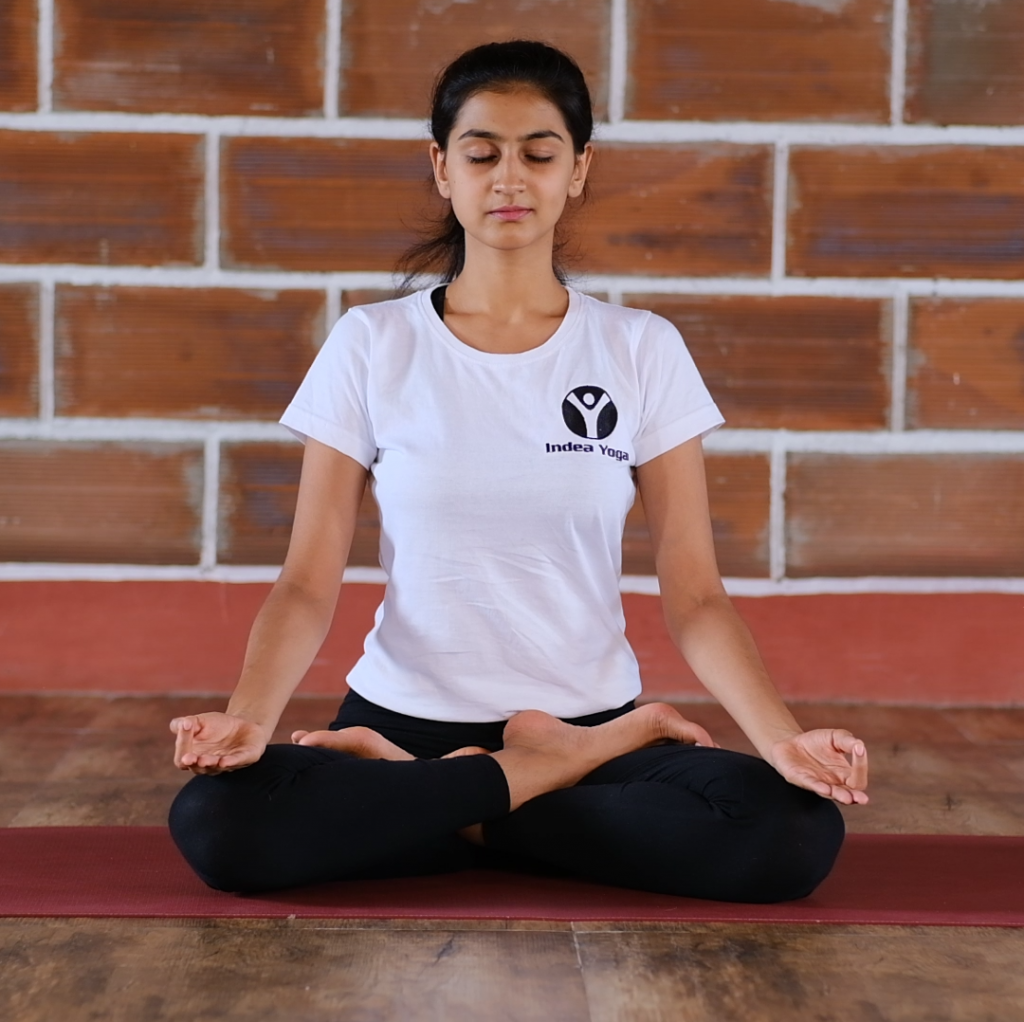
PRANAYAMA
Nadisodhana or Anulom Vilom (Alternate Nostril Breathing)
Sit in any comfortable and steady meditative position. The spine should be erect, the body and mind relaxed, eyes closed. Place the left hand in Chin or Jnana mudrā on the knee, right hand in Nasika mudrā(thumb controls right nostril, ring and little finger control left nostril). Inhale and exhale naturally once through both nostrils. Close the right nostril with the thumb, inhale through the left nostril. Close the left nostril with the ring finger, then release the thumb and exhale through the right nostril. Keep the left nostril closed and inhale back up through the right nostril. Close the right nostril and exhale through the left nostril. This constitutes one round. Breathing ratio is 1 (inhalation – Puraka) to – 4 (retention – Kumbaka) to – 2 (exhalation – Rechaka).
Mudrās:
Left hand: Chin or Jnana mudrā
Right hand: Nasika mudrā
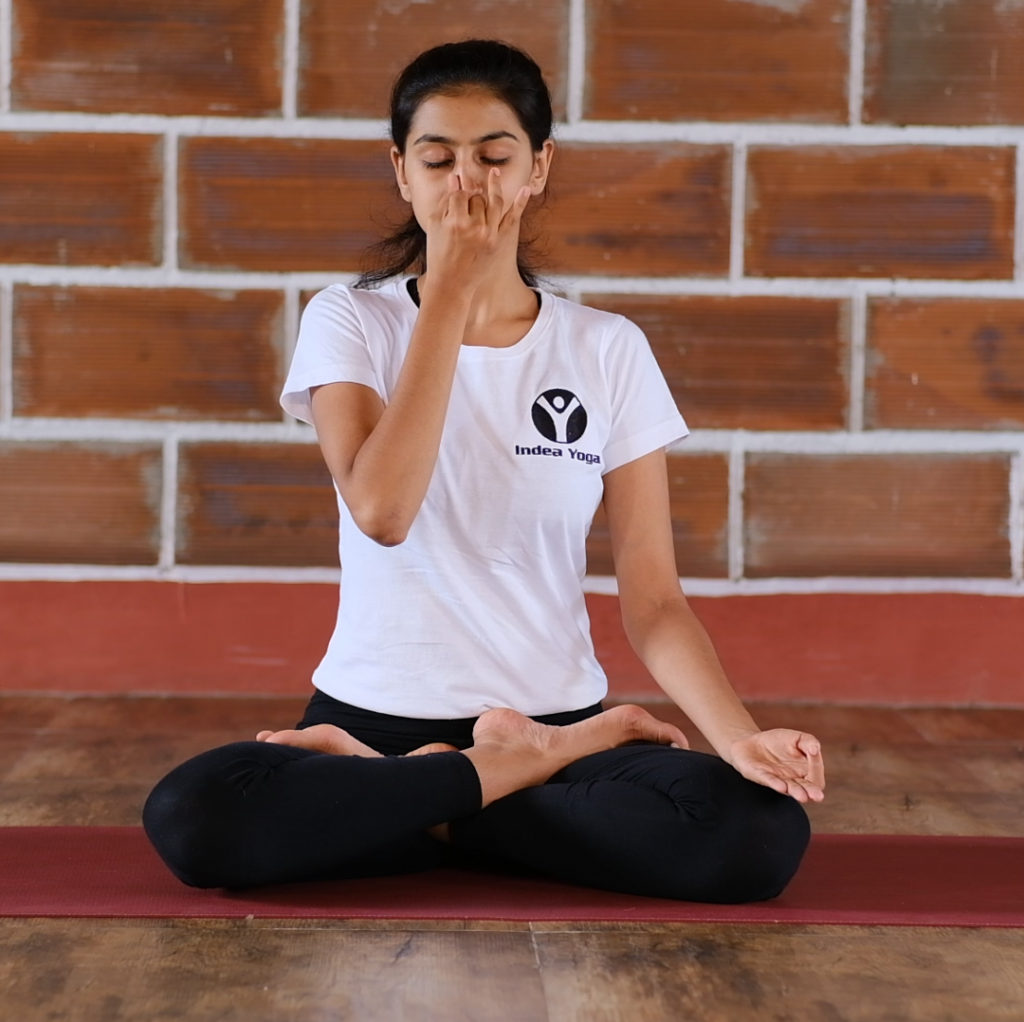
Sitali Pranayama
Sit in any comfortable meditative position with spine uplifted. Hands in Chin or Jnana mudrā. Eyes gently closed. Take a few natural breaths. Open the mouth, stick the tongue out and roll the edges to make a tube. Inhale a full yogic breath through the tongue. Rest the tongue into the mouth normally and close the mouth, hold as long as possible. Exhale through the nose.
Mudrā: Chin or Jnana mudrā.
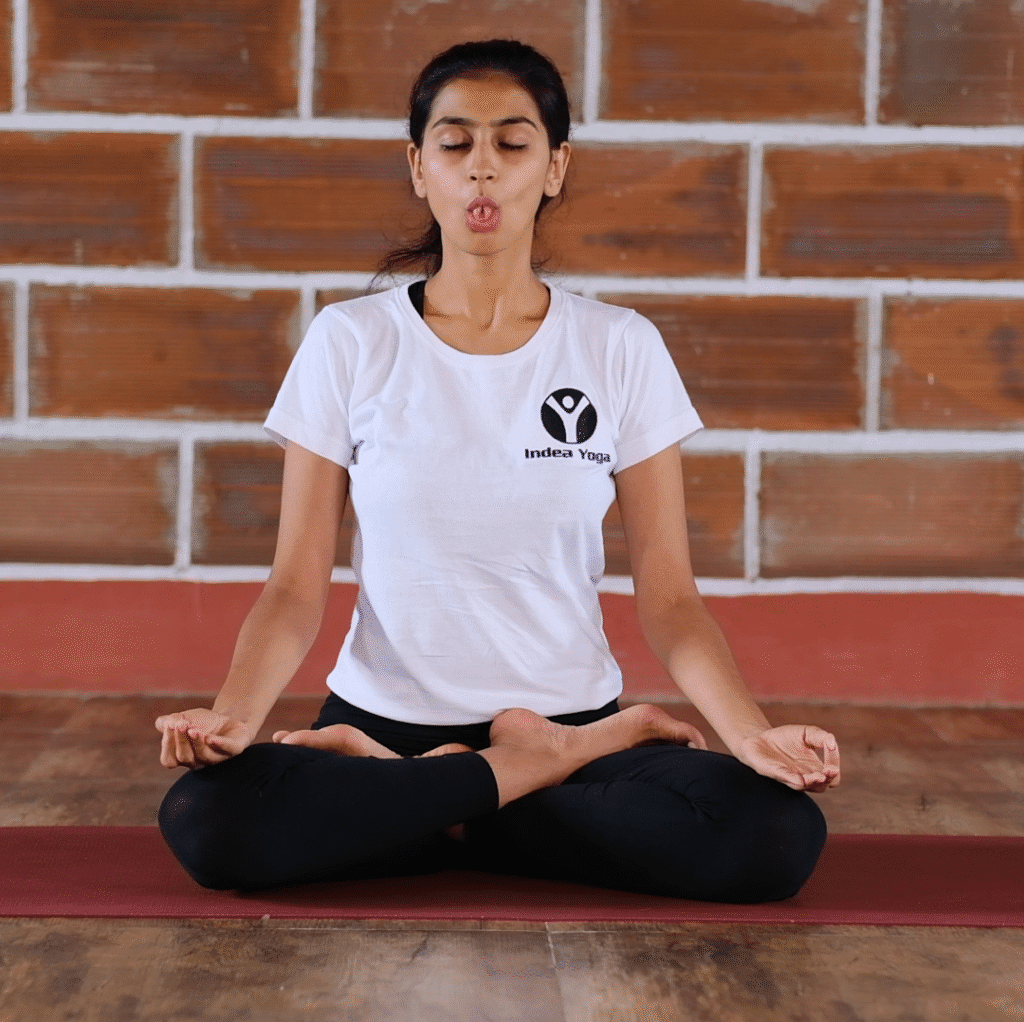
Brahmari
Sit in any comfortable meditative position with spine uplifted. Do natural breathing and bring the awareness to the breath. Gradually bring the awareness to the throat. Watch the breath there. Inhale a full yogic breath through both nostrils. Lift the arms and insert the index or middle fingers into the ear holes, or leave hands in Chin mudrā. While exhaling, make a humming sound, slowly increasing the volume and lengthening the exhalation. After a while, relax and recognize the resonance throughout the head and face.
Mudrā: Lift the arms and insert the index or middle fingers into the ear holes, or leave hands in Chin mudrā.
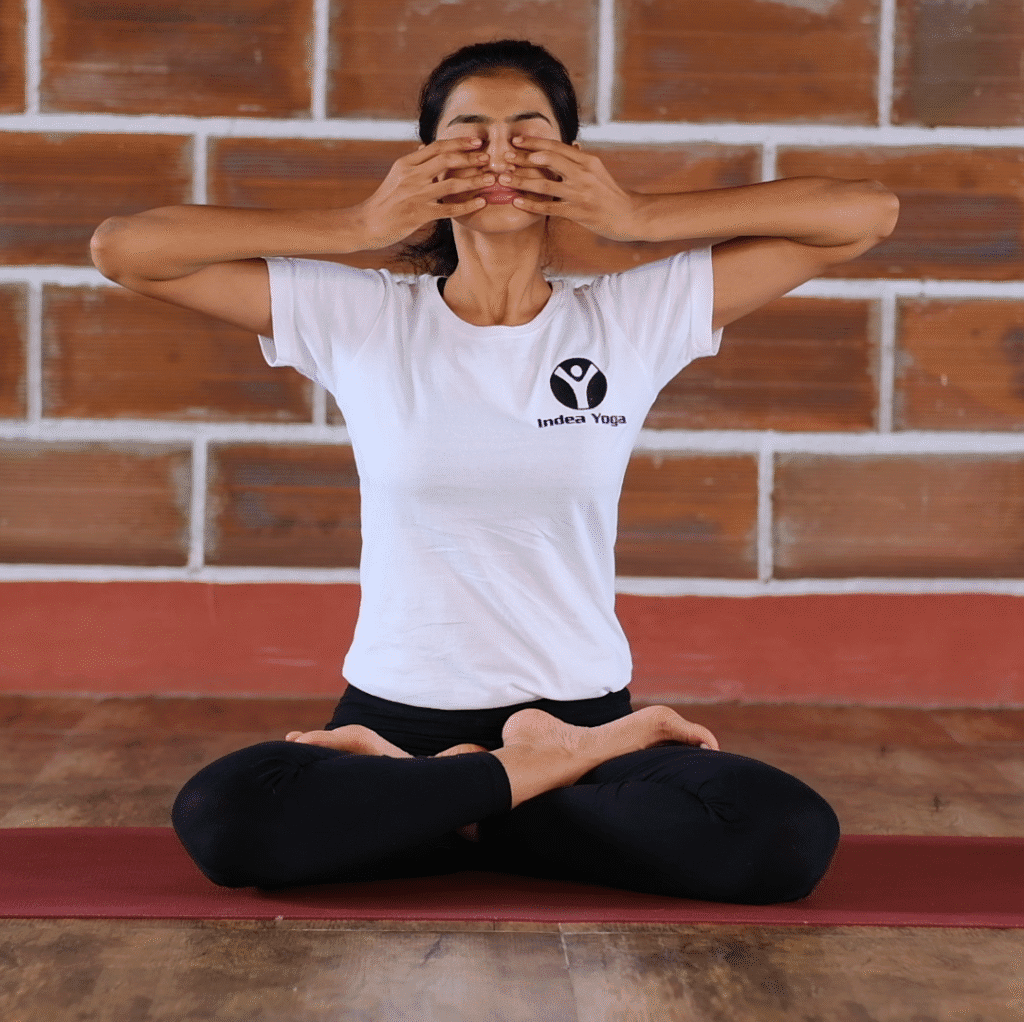
Dhyaana in Shambhavi Mudra
Sit in any comfortable meditation asana. Keep the head and spine upright and straight. Place the hands on the knees in either chin or jnana mudra. Close the eyes and relax the whole body. Relax all the muscles of the face, including the forehead, the eyes and behind the eyes. Slowly open the eyes and look ahead at a fixed point, keeping the head and the whole body absolutely still. Next, look upward and inward, focusing the eyes at the eyebrow centre. The head should not move. When performed correctly the two curved eyebrows will form a V– shaped image at the root of the nose. This point is the location of the eyebrow centre. If the V– formation cannot be seen, the eyes are not converging as they should. Hold the gaze for only a few seconds at first.
Release at the slightest sensation of strain. Close the eyes and relax them. Try to suspend the thought processes and meditate on the stillness in chidakasha, the dark space in front of the closed eyes.
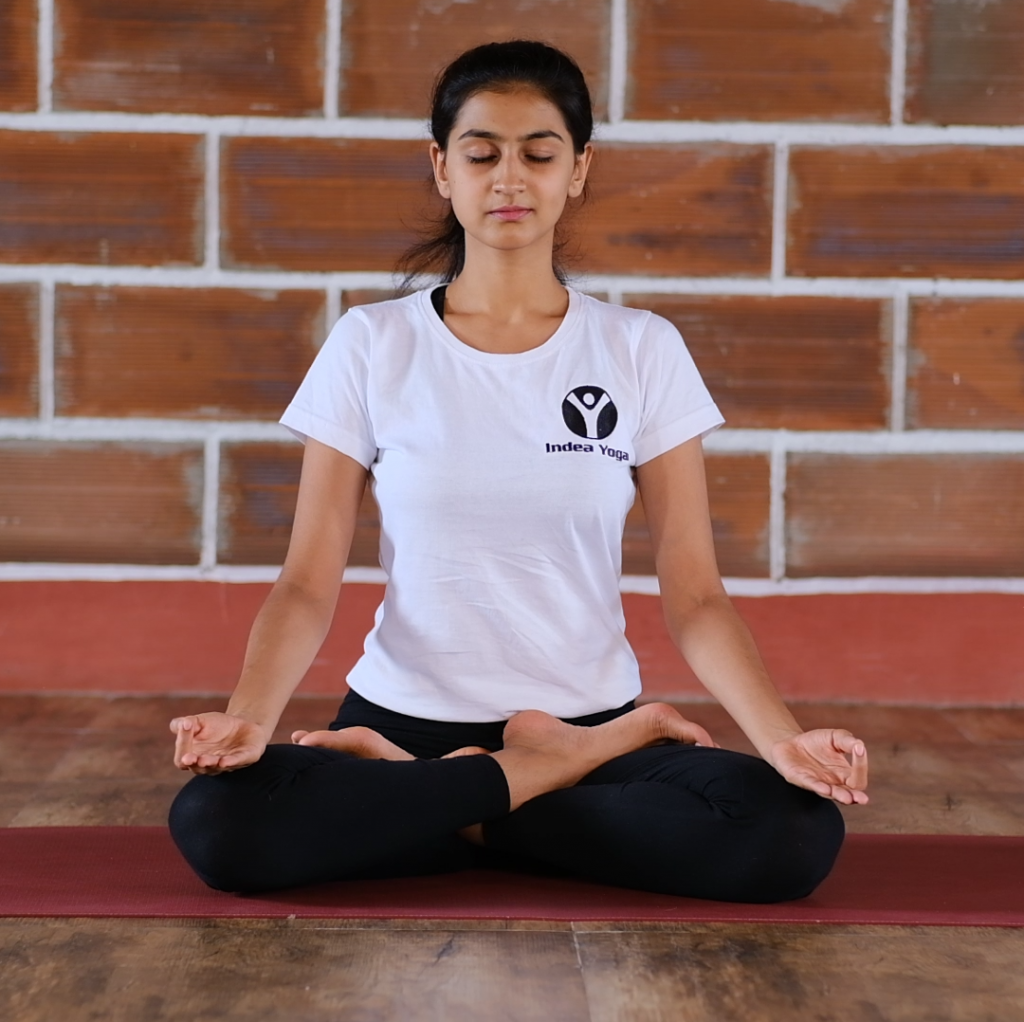
Sankalpa
Hame apne man ko hamesha santulit rakhana hai,
Isi main hi hamaraa atma vikas samaaya hai.
Main apne kartavya khud ke prati, kutumb ki prati, kaam, samaj aur vishwa ke prati, shanti,
anand aur swasthya ke prachar ke liye baddh hun
I commit myself to remain in a balanced state of mind all the time. It is in this state that my development reaches its greatest possibility. I commit to do my duty to self, family, at work, to society, and to the world, for the promotion of peace, health and harmony.
Closing Prayer
Prayer
Sarve bhavantu sukhinaḥ, sarve santu nirāmayāḥ
Sarve bhadrāṇi paśyantu, Mā kaśchidduḥkhabhāgbhavet
ॐ śānti śānti śāntiḥ
Meaning
May all be happy, may all be free from disabilities, May all look to the good of others, may none suffer from sorrow.
Om Peace, Peace, Peace
Reference- IDY common yoga protocol_book
Follow along with us to experience bliss with the practice of these asanas.
International Yoga Day.
Bharatha Yoga PHILOSOPHY
Vision
Health and Bliss for all
Mission
Bharatha Yoga imparts training of yoga practices to all, through the coordination of body, breath and mind. It offers tailor made Yoga practices on the basis of Abyasa, Aarogya and Aananda to the specific needs of people of all age groups, of men and women, considering their prevailing health conditions. Bharatha Yoga will establish contemporary Yoga Shalas across the globe with well-trained Yoga Shikshakas under the guidance of the Yoga Acharya. The Yoga Acharya will provide continuous support to all Yoga Shikshakas and Yoga Shalas across the globe, to ensure that their learning and practice is up-to-date and also maintain a perfect environment of the Shalas.
Core Values
Bharatha Yoga will admit all without any discrimination. We impart Yoga training for specific conditions of the student with a holistic approach. Bharatha Yoga will make practice of Yoga a pleasant experience, with no force or pressure.
General Guidelines for Practice
In the traditional texts, there are innumerable rules and regulations pertaining to pranayama. The main points are: to exercise in moderation, to have a balance and common sense with regard to inner and outer thinking and living. However, for those who seriously wish to take up the advanced practices of pranayama, the guidance of a guru or experienced teacher is essential.
Breathing:
During the practice, always breathe through the nose and not the mouth unless otherwise specifically instructed. The nose should be cleaned regularly by jala neti prior to the practice session. Be aware of the nostrils throughout the techniques. While inhaling, the nostrils should dilate or expand outwards and while exhaling, they should relax back to their normal position.
Time of practice:
Bharatha Yoga suggests that the best time to practice pranayama is during the early morning when the body is fresh and the mind has very few impressions. If this is not possible, another good time is just after sunset. Tranquillizing pranayama may be performed before sleep. Try to practice regularly at the same time and place each day. Regularity in practice increases strength and willpower as well as acclimatizing the body and mind to the increased pranic force. Do not be in a hurry. Bharatha Yoga advises slow and steady progress.
Place of practice:
Practice in a quiet, clean and pleasant room, which is well ventilated but not drafty. Avoid practicing in direct sunlight, as the body will become overheated, except at dawn when the soft rays of the early morning sun are beneficial. Practicing in a draft or wind, in airconditioned rooms or under a fan may upset the body temperature and cause chills.
Sitting position:
A comfortable, sustainable meditation posture is necessary to enable efficient breathing and body steadiness during the practice, Bharatha Yoga suggests. The body should be as relaxed as possible throughout the practice with the spine, neck and head erect. Sit on a folded blanket or cloth of natural fiber to ensure the maximum conduction of energy during the practice.
Sequence:
Pranayama can be performed before asanas with a rest in between, or after asanas and before meditation practice. After practicing pranayama one may lie down in Śavāsana for a few minutes.
Clothes:
Loose, comfortable clothing made of natural fibers should be worn during the practice. The body may be covered with a sheet or blanket when it is cold or to keep insects away.
Bathing:
Take a bath or shower before commencing the practice, or at least wash the hands, face and feet. Do not take a bath for at least half an hour after the practice to allow the body temperature to normalize. Empty stomach: Wait at least three to four hours after meals before starting prānāyāma. Food in the stomach places pressure on the diaphragm and lungs, making full, deep respiration difficult.
Digestion:
When commencing prānāyāma practice, constipation and reduction in the quantity of urine may be experienced. In case of dry motion, stop taking salt and spices, and drink plenty of water. In case of loose motion, stop the practice for a few days and go on a diet of rice and curd or yoghurt.
Diet:
A balanced diet of proteins, carbohydrates, fats, vitamins and minerals is suitable for most prānāyāma practices and is something Bharatha Yoga firmly believes in. A combination of grains, pulses, fresh fruit and vegetables, with a little milk product if necessary, is recommended by Bharatha Yoga .
Avoid strain:
During all prānāyāma practices, it is important to remember that the instructions are not to strain and not to try to increase your capacity too fast, just as it applies to āsana practice. If one is advised to practice a prānāyāma technique for a specific length of time, before moving on to a more advanced practice or breath ratio, it is wise to follow that instruction. Furthermore, breath retention should only be practiced for as long as it is comfortable. The lungs are very delicate organs and any misuse can easily cause them injury. Not only the physical body, but also the mental and emotional aspects of the personality need time to adjust. Do not strain yourself too much in any way.
Side effects:
When practicing for the first time, various symptoms may manifest on a beginner. This is caused by the process of purification and the expulsion of toxins. Sensations of itching, tingling, heat or cold and feelings of lightness or heaviness may occur. Such experiences are generally temporary, but if they persist during the practice, check with your yoga teacher.
Contra-indications:
Prānāyāma should not be practiced during illness, although simple techniques such as breath awareness and abdominal breathing in Śavāsana may be performed. Always consult a yoga therapist or teacher before using prānāyāma for therapeutic purposes.
Avoid smoking:
It is not advisable for prānāyāma practitioners to smoke tobacco or cannabis.

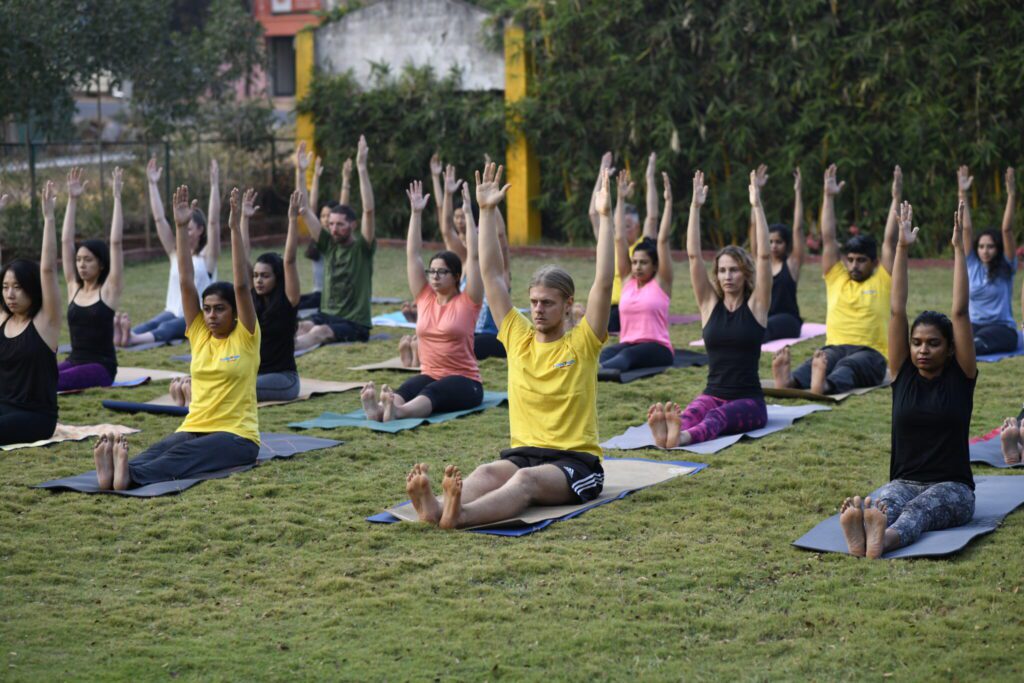

One Response
I really enjoyed reading your article about International Yoga Day and the Common Yoga Protocol. As someone who practices yoga regularly, I appreciate the emphasis that you placed on the importance of maintaining proper alignment and breath awareness during the practice